© 2025 ALLCITY Network Inc.
All rights reserved.

Where in the world do you even start trying to break down the Western Conference Finals between the Colorado Avalanche and Edmonton Oilers?
The star power between Connor McDavid, Leon Draisaitl, Nathan MacKinnon and Cale Makar alone is absurd. Consider that had NHL players gone to the Olympics this past February, three of those four players easily could’ve been on Team Canada’s starting five.
So, you know, there’s some talent on hand here in this series. The storylines here are fascinating, too.
McDavid versus MacKinnon? MacKinnon versus Tyson Barrie? Mikko Rantanen versus Leon Draisaitl? Cale Makar versus the world? Mike Smith versus Darcy Kuemper?
There are just a lot of different angles to look at this series, the first between these two teams since the Oilers upset the Avalanche in 1998.
Let’s start with the obvious, Edmonton’s two-headed monster.
McDavid & Draisaitl
There’s no sugarcoating this going in. Connor McDavid is the best player on earth and he’s playing at the highest level we’ve ever seen from him. He’s tied for the lead in the NHL in postseason scoring with 26 points.
The player he’s tied with is his linemate, Draisaitl, and they have identical stat lines of seven goals and 19 assists. The third player on their line, Evander Kane, leads the NHL in goals with 12. That’s a pretty even distribution for a whole lot of goals.
McDavid and Draisaitl have combined to win three of the last five Hart trophies and McDavid is a finalist again this season after leading the league in scoring with a 123-point season.
Simply put, these two are the league’s most lethal combination and while they were productive apart, getting put together supercharged both of them as they’ve been the best and most dominant line in the NHL this postseason, at least in terms of raw scoring.
When you dig into the underlying numbers, you might be surprised to find that they aren’t generating the kind of dominance you’d expect with those gaudy point totals, but it isn’t like they’ve been bad together.
The McDavid/Draisaitl/Kane combination has played 50 minutes together at 5v5 and outscored its opponents 8-1, but the shot share metrics have that line just in the 50% range together. They score at an unbelievable, and likely unsustainable, rate while doing a decent but not great job of generating scoring chances.
Without Kane, McDavid and Draisaitl post strong numbers together. The best duo, however, has been McDavid with Kane but without Draisaitl. That combination has been incredibly dominant in shot share but only outscored opponents 7-4.
This is really the rub with these guys. They are the world’s best at finishing what they create. They are as high-end as you possibly can get.
How Colorado tries to handle this trio in particular will be an ongoing story for this series because the Calgary Flames, as solid as they are defensively, simply do not have a pairing on the level of Devon Toews and Cale Makar. The Avalanche roll in with their own chess pieces to play.
MacKinnon & Makar
The scoring was down in the St. Louis series, but both Nathan MacKinnon and Cale Makar dominated play against the overmatched Blues. Outside of MacKinnon’s absurd superhero Game 5 performance, it was downright pedestrian production as each player had just three assists.
Colorado was comfortable rolling MacKinnon head-to-head against Ryan O’Reilly throughout the series and while the goals themselves were hard to come by, MacKinnon tore that matchup up with a 66.86% expected goals percentage. The numbers were heavily in favor of MacKinnon, and there’s nobody on Edmonton who can do a reasonable O’Reilly impression.
If Colorado and Edmonton really want to go heavyweight on heavyweight, then this series might get decided by the Kailer Yamamoto and Artturi Lehkonen types instead of the stars at the very top.
Makar here stands out as a fascinating player. He is by far (by faaaaaaaaaaaaaaaaar) the best defenseman in the series but his production came crashing back to earth after the transcendent Nashville series.
There should be ample space for him to work because the Oilers beyond that top line aren’t a group of excellent skaters and defensively they don’t have anyone who belongs on the same ice as him. Makar’s star turn that began in Round 1 has a very real chance to continue here.
While his points might have struggled a bit against St. Louis, like MacKinnon, Makar was territorially dominant throughout. His presence on the ice typically meant Colorado had the puck and his play turned up a few notches toward the end of the series as the Avs were putting the finishing touches on sending the Blues packing yet again.
This might be the first series where Makar’s excellence on defense is required far more than his ability to generate offense. What he’s able to accomplish on that side of the puck will be key to the Avs slowing the McDavid train down.
If Makar and MacKinnon are neutralized again, it’s going to be on Colorado’s depth to make up the difference. They were able to do that against the Blues (interestingly enough), but these guys have to drive the bus. And find Mikko Rantanen and bring him along for the ride.
How did they get here?
Let’s take a look at how solid these two teams were during the regular season.
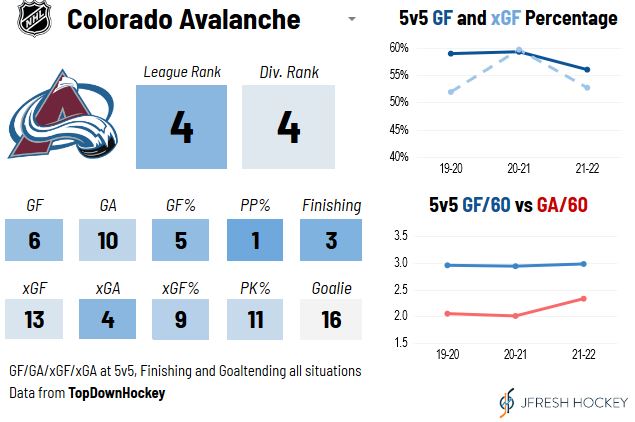
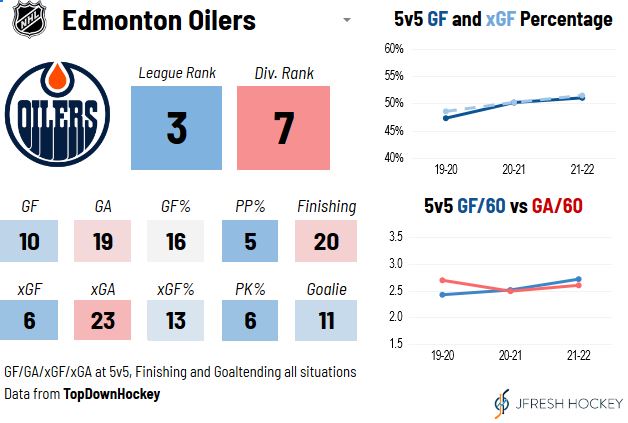
From the regular season, so more of an interesting look at who these teams were. Not incredibly relevant now, but also not meaningless. What I really want to look at is how each team played during the last playoff series. Different matchups and different teams, of course, but I think it’s interesting to show where the overall games are at for each of these clubs.
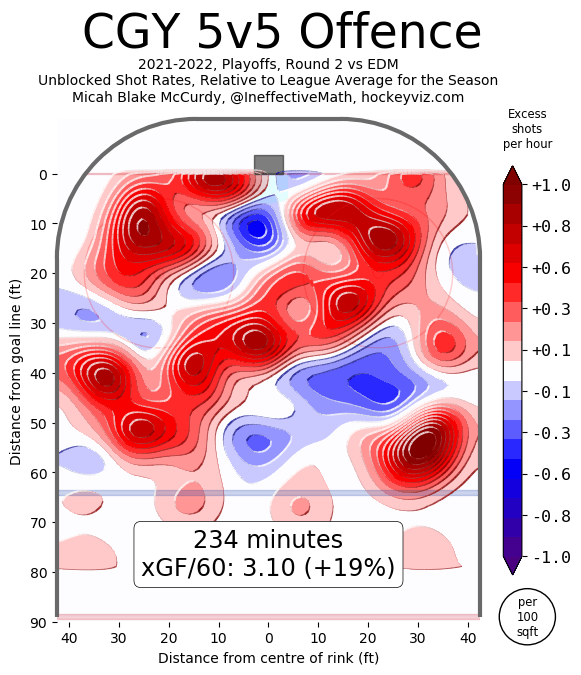
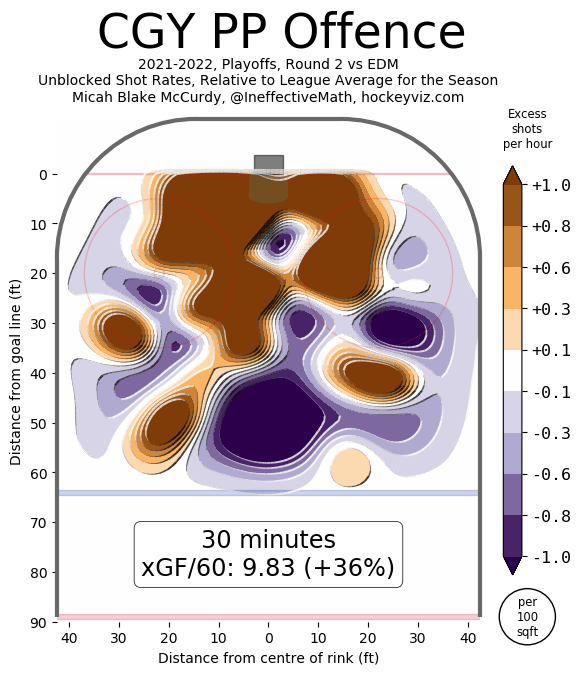
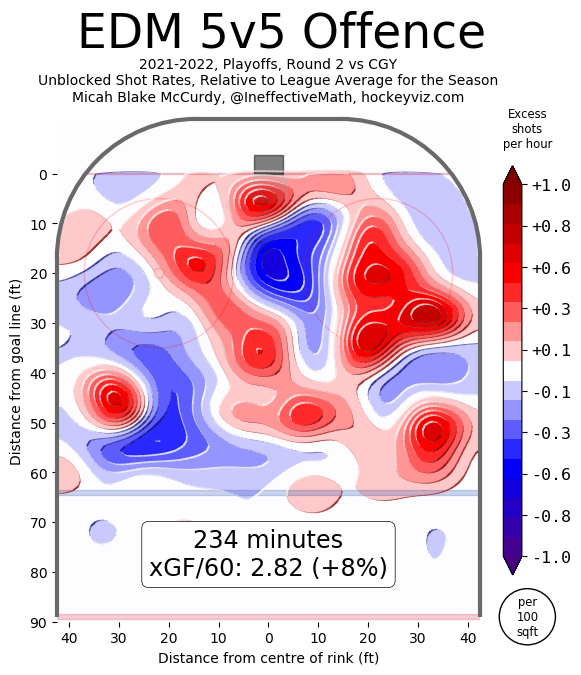
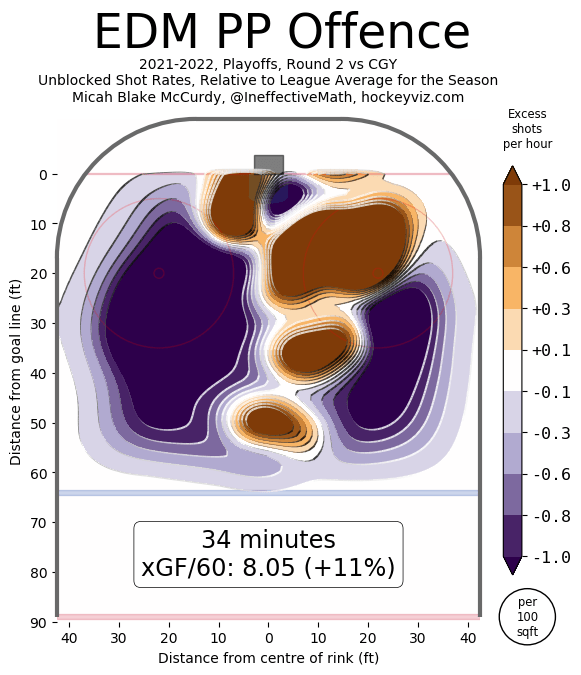
From here, we can see Calgary’s offense was nothing short of awesome in terms of the quality of chances created. They struggled to finish some, but not nearly as much as losing 4-1 in the series might suggest.
The Flames generated tons on offense, tons on the power play, and while the Oilers were good both offensively at 5v5 and on the power play, it just wasn’t to the same caliber.
Flames goaltender Jacob Markstrom’s extremely poor showing in the series (.852 save percentage????) really paved the way for the Oilers to comfortably advance from the Battle of Alberta.
On the flip side, you have Colorado’s performance against the Blues.
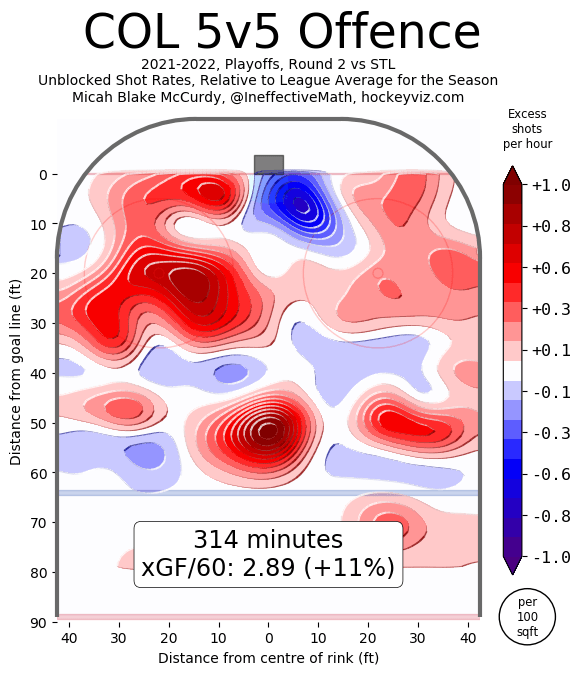
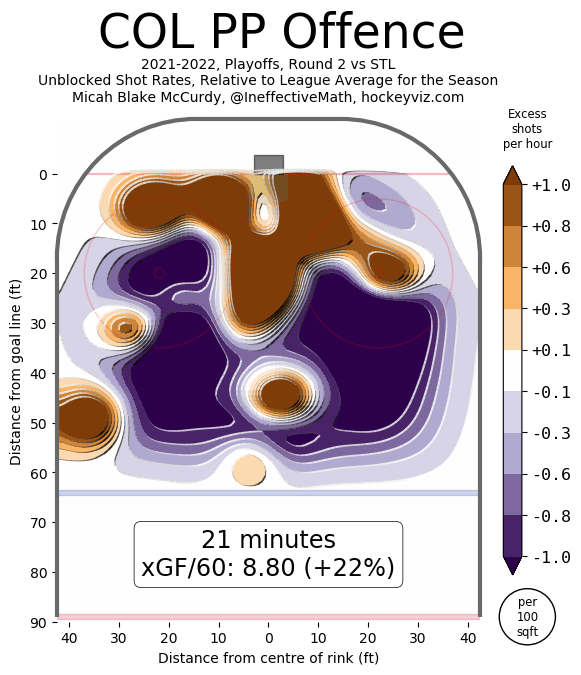
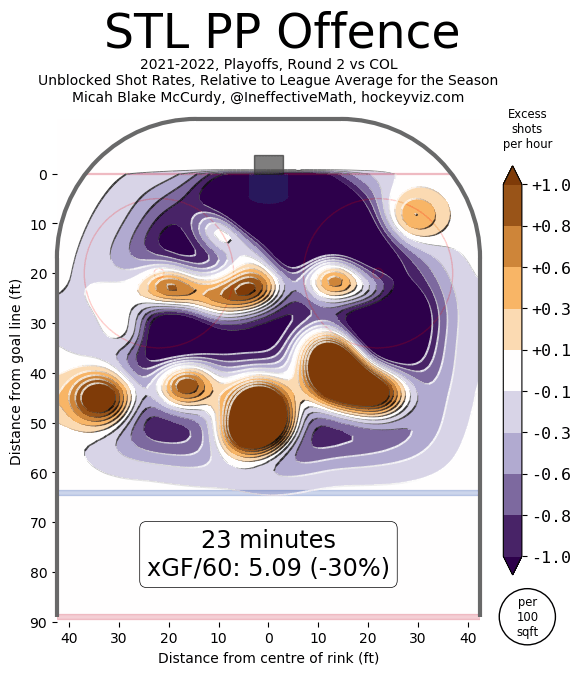
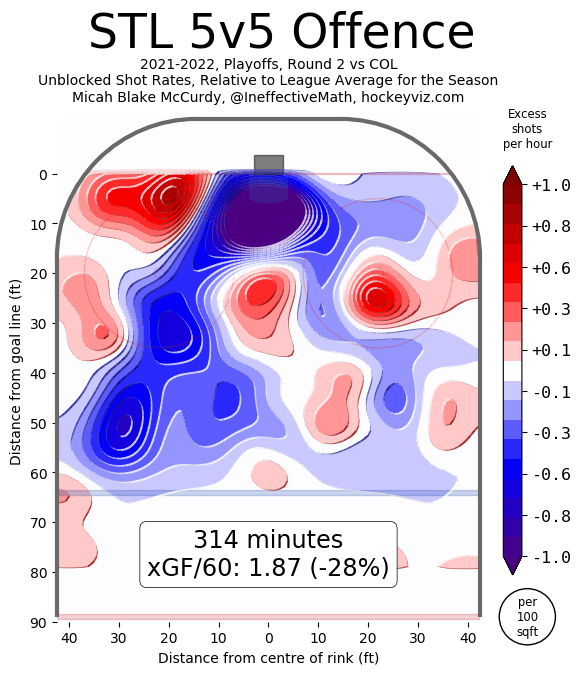
The reality here is that Colorado dominated the Blues throughout the series. They scored a handful of PPGs but we can see from this that they didn’t really generate much in the way of quality or quantity of scoring chances. The Avs did a good job defending, but had their own goaltender struggles from Darcy Kuemper as well as the lion’s share of frustratingly bad puck luck along the way.
At 5v5, it’s extremely encouraging to see what Colorado did to the Blues’ offense. St. Louis really cashed in on the limited chances they got but that vaunted offensive attack with 9 20-goal scorers never really got off the ground.
The Avalanche severely limited the high-danger chances created by the Blues, which was a major strength for St. Louis during the regular season and their series against the Wild. Colorado effectively removed that from the arsenal and the Blues were the benefactors of an awful lot of good fortune throughout the series to produce the results they did manage to get.
Bounces are a thing that happens, just a part of the game that everyone eventually will have to overcome. Colorado didn’t score many goals against the Blues that were of the good fortune kind, but they took advantage of leaky goaltending from Ville Husso to advance.
All of this brings the world full circle here to where I think this series is really going to be made.
Who was right: Ken Holland or Joe Sakic?
Last summer, the goaltender carousel took an incredible spin on the opening day of free agency. As the day wore on, it appeared Sakic and the Avalanche just might be able to outwait Philipp Grubauer’s market and get him back for a reduced price.
When Seattle swooped in and gave Grubauer a monster deal, the Avs suddenly looked like they had played a game of chicken and lost. The last big move available to goalie-needy teams was to call Arizona and inquire about the services of one Darcy Kuemper.
The two teams who battled to the end, each offering a substantial package for one year of Kuemper’s services?
Colorado and Edmonton.
The Avs upped their offer to include Conor Timmins, figuring their pipeline could sustain the loss. The Oilers didn’t have a better piece they were willing to add on top of the first-round pick each team was offering up.
Kuemper landed in Colorado and for most of the year, it appeared Sakic’s aggression in landing Kuemper was a masterstroke versus Holland’s willingness to run it back with Mike Smith on the side of 40.
Once in the playoffs, however, things have changed quite a bit.


In looking at this, Smith has significantly outplayed Kuemper, but let’s talk about it a bit.
For one, this is goals saved above expected, and the Avs lead the NHL in giving up the fewest expected goals per game. This means if Kuemper gives up more than two goals in almost any start, he’s putting up negative GSAx numbers, which can be a little unforgiving.
On the other side, it’s easier for a guy like Smith to accumulate those numbers because he’s backstopping a team that regularly gives up great scoring chances. Even when he gives up a laugher of a goal, he can still get it back.
In truth, Smith has been great for the Oilers, but against a bad goal-scoring team in the Kings and then a Flames team whose stars underperformed (again…), Smith has feasted despite his typical unpredictable, ride-the-wave kind of style. Genuinely, nobody knows which version of Mike Smith is showing up on any given day. He’s either great, or bad. Not much middle ground this postseason for Smith.
All that said, Smith still has to stop pucks and he has. I’ll admit I didn’t watch every second of that series so I can’t speak to the unholiness of hockey bounces, but Kuemper was absolutely on the wrong end of some of them.
That’s hockey, though, and the goaltender’s job is to fight through the chaos and keep giving his team a chance to win the game.
There’s plenty of room for improvement for Kuemper, and Smith is a legitimate reason why the Oilers are even here in the first place. Going into the series, it feels like advantage Smith, but Kuemper hasn’t gotten close to playing his best during this postseason and if he ever breaks through, it’s going to be awfully difficult for the Oilers to win this series.
Rarely do we get to see two teams who jockeyed for the same player’s services end up in a conference finals battle with that player at the center of the success/failure quotient of a playoff series. Whoever wins this series gets to feel their level of investment was perfectly justified.
Battle of the evil exes
This…isn’t really a hockey thing, but everyone under the sun has felt the need to point out that Colorado has played it’s first two picks from the 2009 Draft in the first two rounds in Matt Duchene and Ryan O’Reilly.
Next up is Tyson Barrie.
It is kind of fascinating to see how the Avs crushed the draft that year with three long-term NHL players, including two number one centers. That should’ve been the kind of draft class that redefines an organization. Instead, it was the trading of each of those players that has helped to build the Avs as they are now.
Rarely do teams win deals when giving up established NHL talent but each trade has produced a member of Colorado’s lineup (Duchene: Girard, Byram; O’Reilly: Compher; Barrie: Kadri).
This is more of a silly storyline, especially for those who enjoyed the excellent Scott Pilgrim movie. Fun to consider, but it’s not super meaningful.
Avs Player to Watch
There wasn’t really a natural fit here for this so I created an extra space just to talk about Bowen Byram. We talked on the preview podcast about his role as an x-factor in the series because of his breakout against the Blues, but I really wanted to reiterate that here in this space, too.
Byram was excellent against the Blues in Round 2. While his numbers paired with Erik Johnson, his most common partner by a country mile, are also excellent, this goes way beyond just the numbers.
But my goodness, those numbers. The Avs outshot the Blues 72-38 at 5v5 with Byram on the ice with a 63-25 scoring chance advantage. There are more, but you get the idea. The Avs were special with Byram on the ice.
When Sam Girard got hurt early in Game 3, it was important that Byram step up and try to replace some of the production they’d have gotten from their fallen blueliner. Byram responded with five points in the last three games and has six points in 10 playoff games this year.
They aren’t numbers that will bowl you over or anything, but how many teams have that kind of production from a middle-pairing defenseman?
As Byram’s play continues to ascend, his role will, too, as shown by his usage on the power play and increased minutes at the end of the series. Jared Bednar clearly trusts his young defender and is willing to feed him more responsibility as his game grows.
It has to continue to grow, however. Byram in his current form is really good, obviously, but the deeper the Avalanche get into the postseason the better everyone has to get in order to keep winning games.
Byram was a sneaky-big part of Colorado’s success against St. Louis (as was Erik Johnson, no doubt) and against the offensive juggernaut that is the Oilers he will have to be the best version of himself to date if the Avs are to find the success they seek.
Comments
Share your thoughts
Join the conversation



